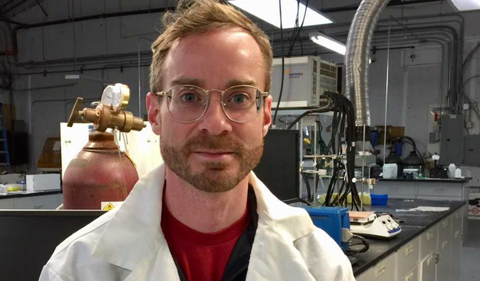
John Staser in his laboratory in Stocker Center
By Ling Xin
NQPI editorial intern
Nanoscale and Quantum Phenomena Institute 2019 Spring Newsletter
Materials expert and NQPI member John Staser is extending his expertise in carbon quantum dots to use these remarkable nanostructures for medical treatment.
Carbon quantum dots, about five nanometers in diameter, display unique optical and electronic properties due to their small size. In particular, they are photoactive, or “fluorescent,” over the ultraviolet range. Staser, an associate professor of Chemical and Biomolecular Engineering in the Russ College of Engineering and Technology, said the fact that these dots are fluorescent and that they are carbon-based—and therefore biologically benign—has inspired researchers like himself to explore their applications in the medical sector, especially for cancer detection.
“The idea is simple,” Staser said. “We attach carbon quantum dots to a cancer antibody and inject them into a person. If the person has cancer cells, the antibody will go to those cells, and we will be able to see that happen by shining (a) UV light onto his body.”
Staser and his colleague Dr. Ramiro Malgor, an associate professor and medical doctor from the Ohio University Heritage College of Osteopathic Medicine, have conducted preliminary experiments to assess the idea’s feasibility. Staser provided Malgor with carbon quantum dots, who injected them into a cell culture to test two things: whether these dots are safe for the cells, and whether they can be detected in the culture.
After two days of cultivation, Staser and Malgor were excited to find out that 95 percent of the cells were alive after being exposed to the quantum dots. And as they shed UV light on the culture, the dots appeared clearly either on the surface of or inside the cells. They concluded these carbon quantum dots can be used for medical imaging.
“Using carbon quantum dots for medical imaging is not a completely new idea. But for the first time, we are applying it to the detection of bladder cancer,” Staser said. Bladder cancer affects millions of people around the globe every year and is treatable if diagnosed early. The current detection involves inserting a probe through the urethra, a painful procedure, especially for male patients. In contrast, quantum dots would be both less invasive and more tolerable.
The potential for this technology is far reaching, as it can be applied not only to cancer detection but cancer treatment. However, work along these lines has just begun, Staser cautioned. A new drug product needs to go through years of testing before it can be used on humans. Staser and Malgor are taking the long road from laboratory experiments to cancer treatment, to find more efficient and effective ways to alleviate cancer.



















Comments